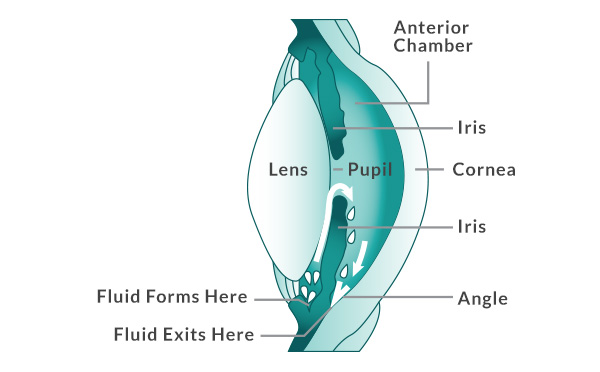Laser Peripheral Iridotomy (LPI) is used for the treatment of patients with narrow angles at risk of developing glaucoma or those who have already developed signs of angle closure glaucoma.
Figure 1.

WHAT IS NARROW ANGLE/ANGLE CLOSURE GLAUCOMA?
In brief, fluid (Aqueous Humor) is constantly produced inside the eye by a certain tissue behind the iris called the Ciliary Body. This fluid flows around the pupil to the front chamber of the eye (the Anterior Chamber) and is drained out of the eye at the ‘Angle’ (see figure 1). There are anatomical variations in different peoples’ eyes and in some, the origin of the iris is located very close to the drain of the eye at the angle resulting in a ‘narrow angle’ configuration. Those with narrow angles are at risk of ‘angle closure’ where this proximity of the iris root to the drain can block access of fluid to the drain, causing a build up of pressure within the eye. This can then lead to glaucoma by damaging the optic nerve (the nerve that transmits sight signals from the eye to the brain). The process of angle closure can either happen suddenly – resulting in ‘acute angle closure’ where the pressure within the eye (the intraocular pressure) rises to a dangerously high level in a matter of hours, causing severe pain and loss of vision; or it can happen more insidiously resulting in a slower rise in intraocular pressure without any notable symptoms but still just as damaging to the vision over time if undetected.
WHAT IS PERIPHERAL IRIDOTOMY & WHAT IS THE BENEFIT?
This is a laser procedure performed in the clinic. It uses very focused pulses of laser energy to create a hole in the outer edge of the iris. This allows a more direct path for the fluid (aqueous humour) to flow into the front chamber of the eye (see figure 2). It changes the fluid dynamics within the eye, resulting in widening of the angle in most people and significantly reduces the risk of acute angle closure. (Note: the aqueous humour is a completely different fluid to your tears. This procedure does not affect the tear drainage or symptoms of ‘watery eye’).
Figure 2.

WHAT HAPPENS DURING THE PROCEDURE?
The laser procedure usually takes a few minutes in each eye to perform using a machine that looks similar to that used for your eye examination. Several different drops will be instilled prior to the procedure to prepare the eye. A lens will then be placed on the eye through which the laser is applied. The procedure is generally painless, but some may feel a degree of discomfort in the eye as the laser pulses are applied. Occasionally, particularly those with dark irises, the procedure may require 2 or more separate stages to complete.
WHAT TO EXPECT AFTER THE PROCEDURE?
Some patients may experience mild discomfort for a few hours after the laser treatment. There may be mild transient blurring of vision for a day or so. Anti-inflammatory drops will be prescribed for one week. Those who are already on anti-glaucoma drops should continue on them unless advised otherwise.
WHAT ARE THE RISKS/SIDE-EFFECTS OF THE PROCEDURE?
Complications after this treatment are uncommon. These include:
- transient intraocular pressure spikes – usually treated by observation alone or addition of anti-glaucoma drops or tablets
- spontaneous closure of the hole created by the laser – necessitating a repeat of the procedure
- rarely, the extra opening in the iris may produce symptoms of glare or double image that are usually transient in most cases
- minor bleeding within the eye during the procedure is very common and rarely causes any problems.
If there is further information you would like to discuss about peripheral iridotomy, please don’t hesitate to consult one of our doctors at Applecross Eye Clinic.
